CM603: How to Locate Planet Nine
David Noel
<davidn@aoi.com.au>
Ben Franklin Centre for Theoretical Research
PO Box 27, Subiaco, WA 6008, Australia.
What is Planet Nine?
By current reckoning, our Solar System contains eight planets, with Neptune being the farthest from the Sun, at about 30 AU (1 AU or Astronomical Unit is the distance from the Sun to the Earth, about 150 million kilometres).
On the older view, there is a ninth planet called Pluto. However, in 2006, the definition of "planet" was revised, and Pluto was demoted to the status of "dwarf planet", among the group of TNOs (Trans-Uranian Objects) described below. This article is not about Pluto, but about "Planet Nine", a possible large new planet far, far out from the Sun.
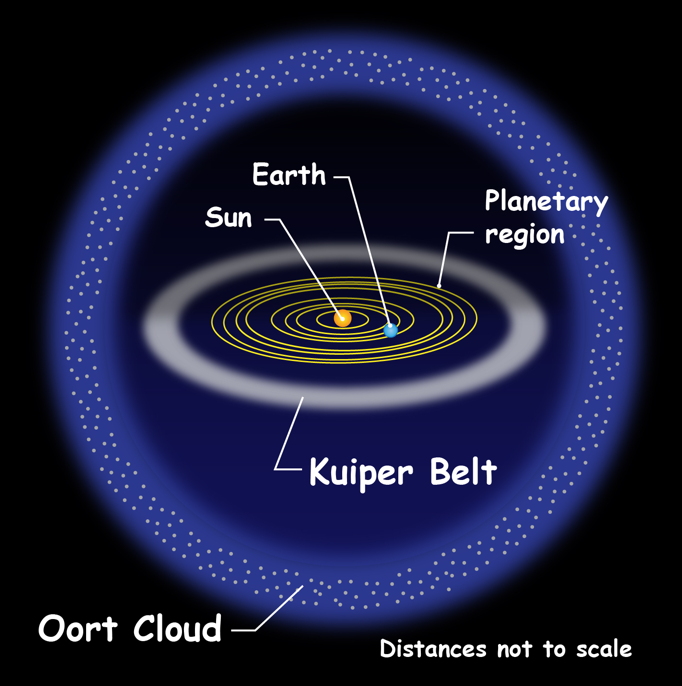
Figure CM603-F1. Simplified diagram of the Solar System, with the Kuiper Belt and the Oort Cloud. From [2].
Our Solar System exists within a 100-AU-radius sphere called the Heliosphere. The Heliosphere is a physical entity which is moving through the local area of interstellar matter, which we call the Oort Cloud.
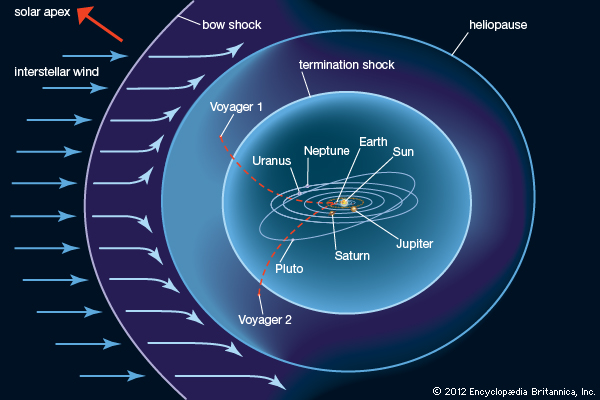
Figure CM603-F2. The Heliosphere. At the heliopause the outward pressure of the solar wind balances the pressure of the incoming interstellar medium. From [3].
The part of the Solar System which exists between the outermost planet (Neptune) at 30 AU, and the edge of the Heliosphere at 100 AU, may be called the Kuiper Belt. It contains a number of dwarf planets, often on notably non-circular orbits. These are also called Trans-Neptunian Objects (TNOs). Sometimes the Kuiper Belt is reckoned to stop at about 50 AU, and the region beyond that is called the Scattered Disc.
Pluto is now considered a dwarf planet and a TNO. The eight standard planets all orbit the Sun in an approximate plane, while the orbits of Kuiper-Belt objects may be tilted quite a lot out of this plane. The further you go from the Sun, the more orbital planes are tilted, and by the time you reach the surrounding Oort Cloud, orbits may be at any angle to the plane of the planets.
The Oort Cloud is represented as a sphere. It is not a physical object, but just a convenient way of representing matter and bodies which lie outside the Heliosphere. Sometimes our local Oort Cloud is represented as extending halfway to the nearest stars, 4 light-years away. Oort Cloud material may be called Oort Soup (What is the Oort Soup?).
The existence of quite a few TNOs had been confirmed by the end of 2017, some the size of Pluto, and one, Eris, of greater mass than Pluto [4]. Many of these TNOs also have one or more moons.
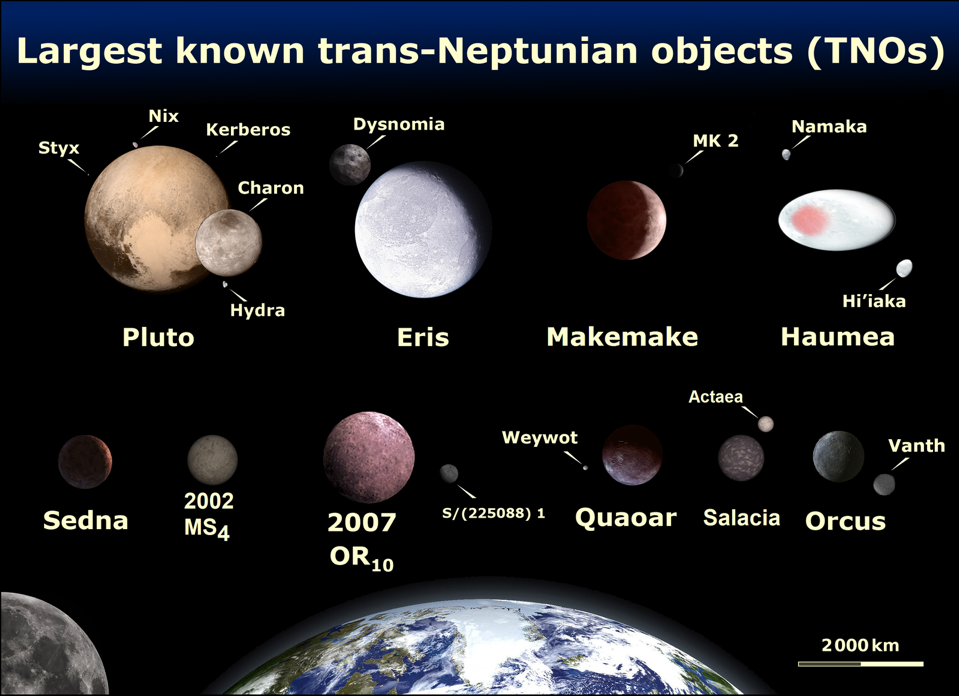
Figure CM603-F3. Sizes of Trans-Neptunian Objects, compared with sections of Moon and Earth. From [4].
These TNOs are a long way from Earth. They usually have very elliptical (non-circular) orbits, so that they are sometimes closer to the Sun, and sometimes very distant. Pluto can get closer to the Sun than Neptune's orbit -- it did this from 1979 to 1999. However it can't collide with Neptune as their orbits don't actually overlap.
The following animation (from Wikipedia [1]) gives some idea of the distances involved. Because of the variation in distances involved, it has three changes of scale. It starts off with the Inner Planets (Mercury, Venus, Earth, Mars). The scale then contracts down to show the Outer Planets (Jupiter, Saturn, Uranus, Neptune).
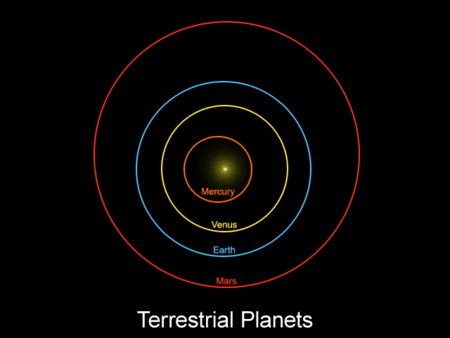
Figure CM603-F4. Planet Nine and the Solar System. From [1].
In the last contraction, orbits of some of the TNOs are shown. For most of their orbits, the TNOs may be well outside the 100-AU boundary of the Solar System -- some go out to over 5000 AUs [5].
Out in the Wild Black Yonder
So we're looking at bodies a long way from our traditional old Solar System. Some of the TNOs (such as Pluto) stay entirely within the Solar System, some dip in and out, others have orbits which are entirely outside the Solar System.
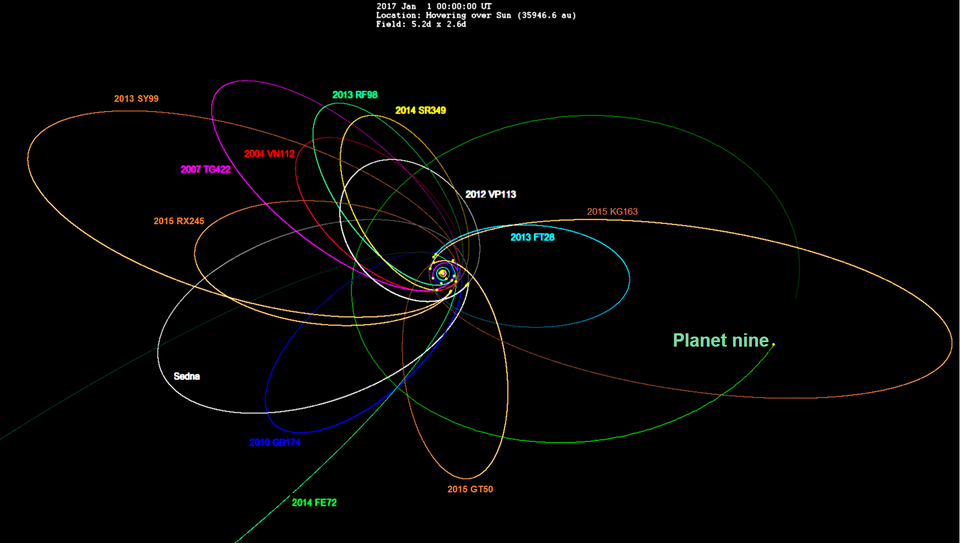
Figure CM603-F5. Orbits of TNOs, the hypothetical Planet Nine, and the Solar System. From [1].
Notice that some of these orbits are almost at right angles to the plane of the Solar System. Notice also that in the third frame of the animation, many of the orbits were skewed to one side, suggesting some sort of gravitational imbalance. It is this gravitational imbalance which has led to the suggestion that the skewed orbits are balanced by an as yet unseen massive planet, that is, Planet Nine.
Wikipedia [1] sums it up as follows:
"Planet Nine is a hypothetical planet in the outer Solar System. Its gravitational influence could explain the abnormal orbits of a group of trans-Neptunian objects (TNOs) found mostly beyond the Kuiper belt.
Speculation about the alignment of TNOs began with a 2014 letter to the journal Nature. Astronomers Chad Trujillo and Scott S. Sheppard noted the possible existence of a trans-Neptunian planet after comparing the similar orbits of trans-Neptunian objects Sedna and 2012 VP113.
In early 2016, researchers Konstantin Batygin and Michael E. Brown described how the similar orbits of six TNOs could be explained by Planet Nine and proposed a possible orbit for the planet. This hypothesis could also explain TNOs with orbits perpendicular to the inner planets and those with an extreme tilt.
The hypothetical planet could be a super-Earth with an estimated mass of 10 Earths, a diameter two to four times that of Earth, and an elongated orbit lasting approximately 15,000 years".
Suggestions of previously undetected planets from their gravitational influence on other bodies is not new. It was the case for Uranus, Neptune, and Pluto in the past, each was found from unexplained discrepancies in the orbits of previously-known planets closer to the Sun.
A visual grasp of the immense distances involved can be had from an artist's impression of the view from behind Planet Nine, seen against the background of the Milky Way. The little bright oval to the right is the entire Solar System.
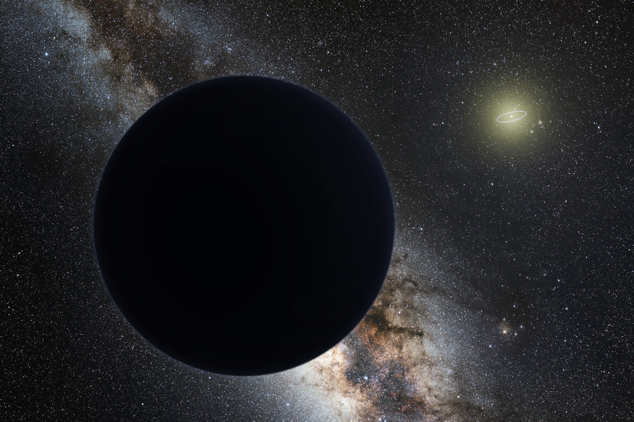
Figure CM603-F6. An artist's impression of Planet Nine. From [1].
Locating Planet Nine
As at the end of 2017, Planet Nine has not been visually detected. So, assuming that it's a real body, why don't they just point a powerful telescope at the right spot and get an image?
It's because the distances involved are so large. Planet Nine's projected elliptical orbit takes it 200 AU distant at its closest to the Sun, and 350 AU at its farthest. Its orbit is projected to be tilted at some 30 degrees to the plane of the planets. It is always well beyond the boundary of the Heliosphere, and so is an Oort Cloud Object (OCO).
This has a number of consequences. When Pluto was first detected, at about 30 AU, it was only from the movement of images taken some time apart on long-exposure photographic plates. Even with the most powerful telescopes we have today, none can resolve Pluto as a disc. That had to wait until we could send space probes to pass close by.
Moreover, even if we were satisfied to record Planet Nine as a point light source, we don't know exactly where to look, as gravitational calculations just aren't that precise. And, to detect such an object by reflection of its light from the Sun, we are talking about a very, very tiny amount of light.
Light falls off as the square of the distance. Suppose, just for a calculation, that Planet Nine (P9) was at 240 AU from us. At 60 AU, a body would receive a quarter as much light as Pluto at 30 AU, at 120 AU a quarter of that, and at 240 AU one-sixty-fourth as much. So to go from the Sun to P9, and then back to us, we would have received only one-sixty-fourth squared as much as from Pluto. That works out at about 2.4 ten-thousandths, over three orders of magnitude less.
We can continue a conventional search to find P9 by its reflected light, and eventually it should succeed. But there is a better way.
How bodies in space radiate
All solid bodies in space radiate from their surfaces, and the wavelength of this radiation depends on their surface temperature. The radiation is called thermal or black-body radiation (Does everything give out electromagnetic radiation?)
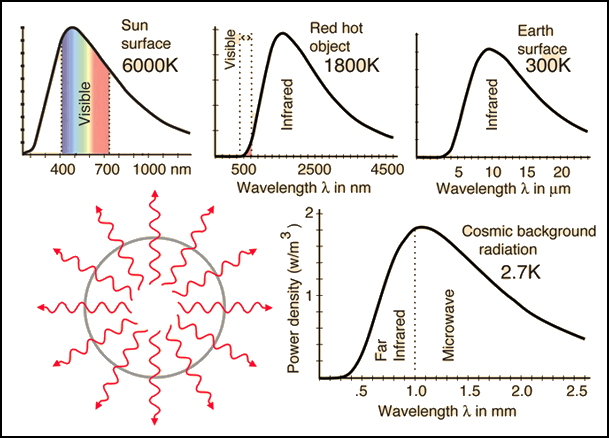
Figure CM603-F7. Black-body radiation. From [6].
The figure shows typical black-body radiation from bodies at various temperatures. The surface of the Sun, at about 6000 K (degrees Kelvin), radiates over the whole visible-light spectrum, with some ultraviolet and some infrared. A bar of iron heated to 1800 K radiates mostly in infrared, with a tiny bit of red visible light.
For the Earth's surface, at a nominal 300 K (equal to 27 degrees C), radiation is entirely in the infrared. And for very distant bodies in the Oort Cloud, at temperatures of under 3 K, radiation is at much longer wavelengths in the infrared and microwave bands.
The radiation given out is not all at one wavelength, but is spread out over a curve, as in the following graphic. The peak wavelength, at the top of the curve, can be calculated for a given temperature, using a formula which applies over the whole electromagnetic spectrum.
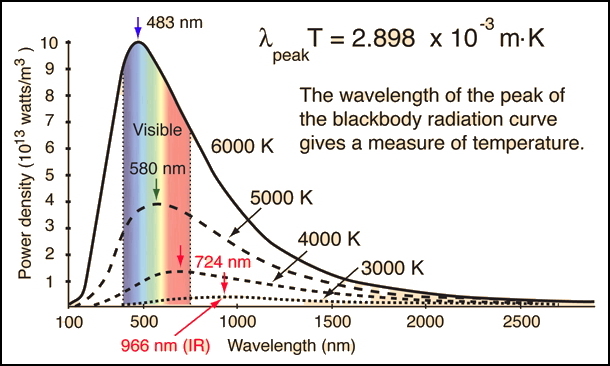
Figure CM603-F8. Black-body radiation curve. From [7].
From the peak, the power of the radiation falls away fairly steeply with shorter wavelengths (higher frequency, more energy), to the left in this representation. The slope of fall for longer wavelengths, on the right, is much more gradual, tailing away slowly.
What temperatures are TNO and OCO bodies at?
So we know that the black-body peak for objects distant from the Sun should extend out to longer wavelengths (lower energies) as their distances from the Sun increase, and their surface temperatures fall. This is roughly supported by available measurements in most cases, but there are difficulties.
One difficulty is with their atmospheres. All the planets from Venus out have atmospheres, but these vary greatly in depth and density. The black-body formula applies at the surface of the radiating body, but where this surface lies, and whether radiation is occurring at a higher level than any solid surface, may be difficult to determine.
Take Venus. Venus has an atmosphere approaching a hundred times the density of Earth's. The temperature at its surface is known to be very high, much higher than that at the surface of Mercury, which is closer to the Sun. Why should this be?
The answer is, that measuring a temperature at the bottom of a massive atmosphere has to give you a higher reading than would a measurement under a thinner atmosphere. If you recorded temperatures at a depth of 1 kilometre below the surface of the Earth (under a similar pressure to that on Venus), your readings would be about 25 degrees higher than those on the surface. There is more explanation of this at [15].
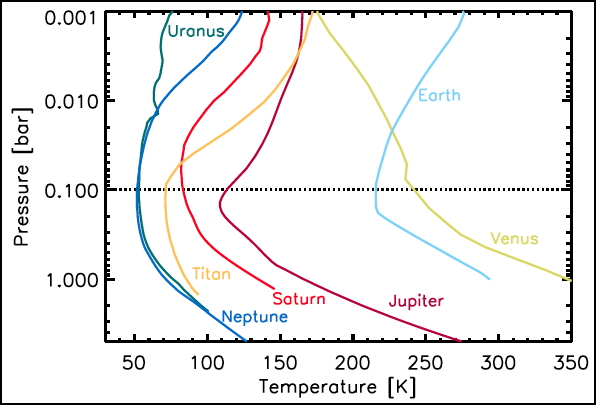
Figure CM603-F9. Adjusted planetary surface temperature calculations. From [8].
The above figure shows expected planetary temperatures adjusted for various atmospheric levels. At the central dotted line, which is for a pressure of about a tenth of Earth's atmospheric pressure, the planets do line up fairly well, with lower temperatures for planets more distant from the Sun. But there are still discrepancies, particularly with Uranus and Neptune -- Neptune, further from the Sun, would be expected to be appreciably colder than Uranus.
The reason for this anomaly, and other discrepancies, is to do with heat generated within the planetary cores.
Heat generated within planetary cores
We know that as well as radiation received from the Sun, the Earth's energy budget contains an amount for heat generated from within. For the Earth, the core-generated energy is tiny compared to the solar radiation, less than a tenth of one percent.
But as you move out beyond Mars, the position alters dramatically. Jupiter generates more heat from its core than it receives from the Sun. This is partly because Jupiter is much more distant from the Sun than Earth, and partly because it has a much more massive core. Beyond Jupiter, core-generated heat becomes significantly more important than solar radiation received. There is more detail on the mechanisms involved at [16].
According to figures given in [9], Jupiter has an average temperature of 128 K, Saturn is at 105 K, Uranus at 49 K, and Neptune at 55 K. The same reference notes that Jupiter has a very hot core, while the Uranus core produces only one-fifth the heat that Jupiter does, and less than half of that from Saturn. It also notes that Neptune has a hotter core than Uranus.
According to XT807: The Concore Model of planet and star interiors, bodies in space of mass somewhat above that of Mars still contain active heat-generating cores from the time of their formation some 4.7 billion years ago. Also, the more massive the body, the greater the amount of core heat which it is producing.
This does explain a hitherto puzzling fact, that Neptune is hotter than Uranus even though it receives less radiation from the Sun. According to NASA's planetary data [13], the relative masses of Jupiter, Saturn, Uranus, and Neptune are 317.8, 95.2, 14.5, and 17.1. So their temperatures follow their masses, and presumed core activity, quite closely.
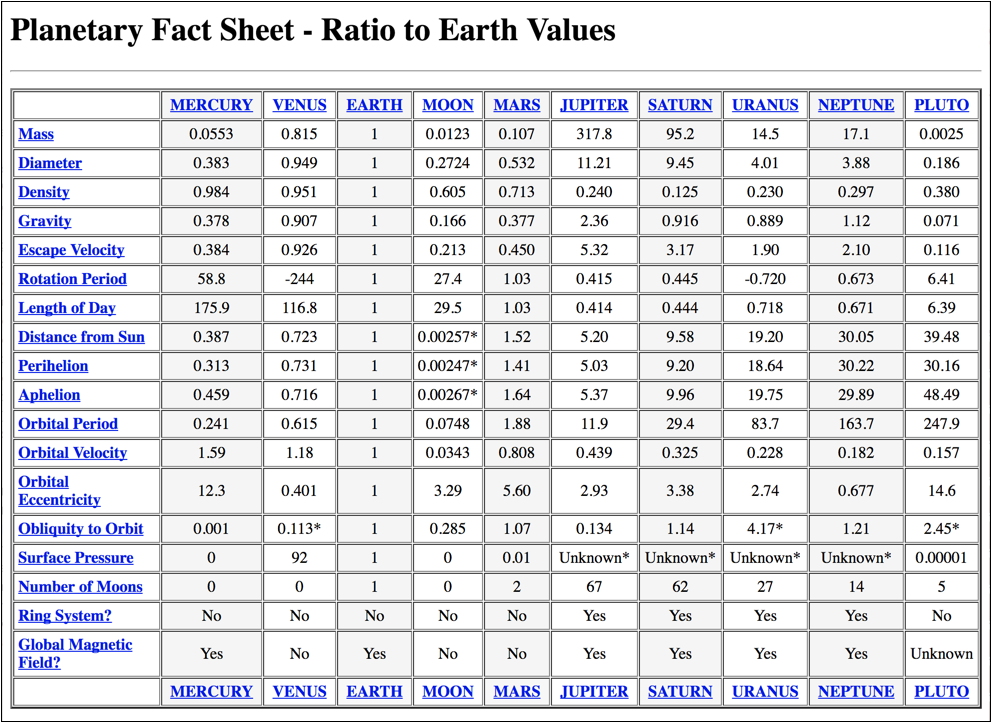
Figure CM603-F10. NASA data for the planets. From [13].
Beyond the planets -- TNOs and OCOs
Beyond Neptune, the main influence on the temperatures of TNOs (Trans-Neptunian Objects) and OCOs (Oort Cloud Objects) will be the radiation they receive, principally that from the Sun.
The amount of this radiation is easy to calculate -- it falls off as the inverse square of the distance. And a handy little calculator included in [14] gives you the solar radiation at any distance from the Sun -- a screenshot of this calculator is shown below.
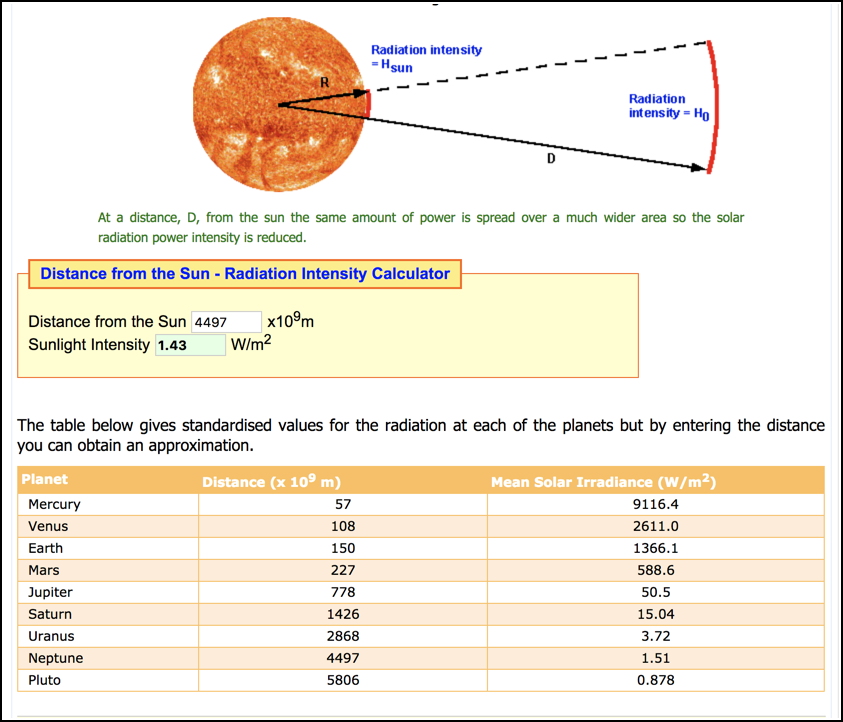
Figure CM603-F11. Solar radiation and the planets. From [14].
Another useful calculator, at [12], gives you the peak black-body emission wavelength for a body at a given temperature. These tools allow you to estimate the temperatures of TNOs and OCOs, according to their distances from the Sun. You can also look up the black-body peak wavelength for a body at a given temperature.
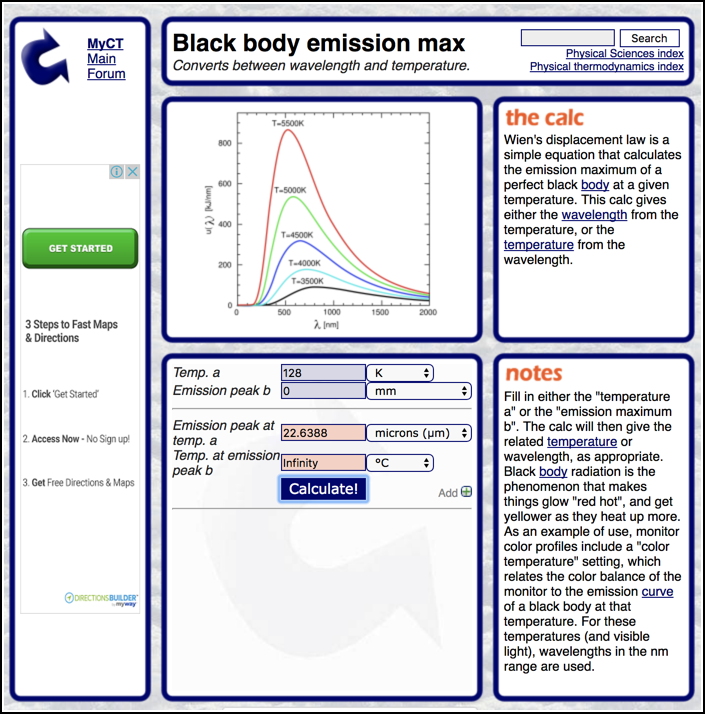
Figure CM603-F12. Calculating emission wavelength for a given temperature. From [12].
The average temperatures for Jupiter, Saturn, Uranus, and Neptune were mentioned above. Slotting these temperatures into the calculator [12] gave the following peak wavelengths (in microns, millionths of a metre):
Jupiter, 23
Saturn, 28
Uranus, 59
Neptune, 53
Longer wavelengths mean lower energy and lower temperatures, so that Uranus (smaller and less core activity) has a greater peak wavelength (lower energy) than Neptune, even though Neptune is more distant from the Sun. In fact, for the larger core-active planets distant from the Sun, the Sun's received heat is negligible compared to the core-generated heat.
But this is only true for more massive bodies, more massive than Mars. Everything we knew of beyond Neptune, TNOs and OCOs, has been relatively small and core-inactive, and so its temperature will be determined by its distance from the Sun.
At the outer surface of the Heliosphere, at the inner surface of the Oort Cloud, the temperature of a smaller body will be about 3 K, three degrees above absolute zero. At this temperature, its peak wavelength will be 966 microns, just under the far-infrared/microwave boundary at 1000 microns (see Figure F7 for a quick reminder).
Move further out still into the Oort Cloud, and the temperature of a body will drop still further, but not by very much, because the energies involved are already very minimal. At 2.74 K, which would correspond to a position far out into the Oort Cloud, the peak wavelength would be 1061 microns.
Several major satellites have been launched into space to detect incoming radiation of around this wavelength. One of these was NASA's Cosmic Background Explorer (COBE). The following figure shows the COBE results.
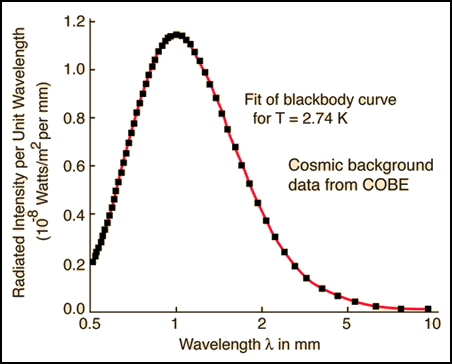
Figure CM603-F13. Calculated emissions and data from the COBE satellite. From [17].
On the figure, the black dots are COBE measurements of radiation intensity at particular wavelengths. It can be seen that these fit very closely on a black-body radiation curve for a temperature of 2.74 K.
This incoming radiation is called CMBR, Cosmic Microwave Background Radiation. The Universe is flooded with radiation at all times, and over 70% of it is CMBR [18], so it's quite important. By contrast, visible radiation or light (the part we notice most) makes up less than 3%. Most of the rest is infrared.
It would seem almost self-evident from the above, that CMBR is just incoming black-body radiation we receive from bodies in the Oort Cloud which surrounds us. The data is fine, but there has been, in my view, an unfortunate misunderstanding of what it represents.
The conventional view is that CMBR is "radiation left over from the Big Bang". It was supposedly created at much shorter wavelengths, during "the early period of the Universe", but has been hugely stretched out by "expansion of the Universe".
This conventional view is essentially untenable by applying a little logic. It is not really feasible that readily-absorbed radiation, created "some 13.7 billion years ago", could still exist and be making up 70% of the universal radiation. And this is 70% by energy -- in terms of photons, CMBR would be over 95%.
Nor is it feasible that CMBR, supposedly created at a visible-light frequency, could be stretched out to end up in microwave range, by a mechanism which somehow did not reduce other visible light from very distant sources (and so of similar great age) to microwave range also.
Those interested in the story of how the CMBR-origin error came about may find it at P2: The Oort Soup as the real origin of Cosmic Microwave Background Radiation [19].
Formation of planets and solar systems
We can move on now to the nature and distribution of the Oort Soup, the interstellar matter in Oort Clouds throughout the Universe, and how solar systems and planets, including Planet Nine, may have been formed.
According to most current conventional beliefs, solar systems were formed from "Protoplanetary Discs", flat discs of gases and dust rotating around newly-formed stars, possible as a result of the star-formation process.
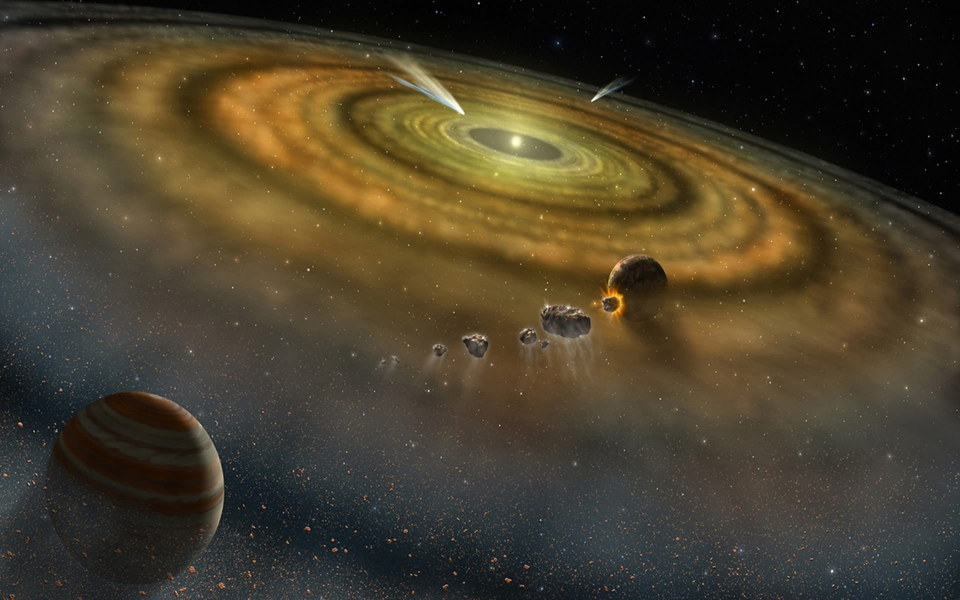
Figure CM603-F14. Artist's conception of a protoplanetary disc. From [20].
Planets and other bodies were formed by gravitational aggregation of matter in the discs. In [20] it says "Born in a disc of gas and rubble, planets eventually come together as larger and larger pieces of dust and rock stick together. They may be hundreds of light-years away from us, but astronomers can nevertheless watch these planets as they form".
Here is another instance of a misleading interpretation of good data, perhaps for fair enough reasons. The concept of the "protoplanetary disc" had its beginnings back in the 1700s, when the idea of a "planetary nebula" was introduced. This blob of various gases and small solids was assumed to gravitationally accumulate a major mass at its centre, the incipient star.
The biggest objection to the model came from astrophysicists, who pointed that the relationship between the angular momentum of the Sun and the planets was not what would be expected. But it has to be remembered that for scientists in the relatively recent past, the only example known of a solar system, was our own.
Since the dawn of the space age in the 1950s and the discovery of extrasolar planets in the 1990s, the protoplanetary disc model has been both challenged and refined to account for new observations [21]. In its support, actual examples of what appear to be discs of material have been observed rotating around a number of stars.
However, with the increasing amount of information on TNOs and their orbits, the viability of the protoplanetary disc idea is more and more in doubt. Look back at Figure F5, showing the orbits of TNOs, varying wildly from the equatorial plane within which the planets orbit. A protoplanetary disc origin could not result in such orbits.
To understand the processes which lead to the formation of solar systems and planets, including Planet Nine, a new look at the situation was needed.
The Cosmic Smog model and Equatorial Forcing
In 2014 I introduced a new model of solar-system formation, working from a quite different direction to the older models. Instead of assuming that planets originated after the formation of a star, the opposite was assumed.
The usual processes of larger bodies being built up from smaller material by gravitational attraction was taken as valid, but these processes were assumed to take place independently of any stars, in the vast voids of interstellar space. Instead of planets being formed in conjunction with the formation of stars, stars were just examples of matter accumulations which happened to reach a critical mass.
This critical mass is around 7% of the mass of our Sun. This is currently reckoned to be the minimum mass for a body to undergo "ignition", to commence fusion of hydrogen and begin to emit its own light.
The material from which bodies aggregated, the Cosmic Smog, ends up as Oort Soup, solid bodies of every size, up from dust through to planetesimals and planets, right up to giant rogue planets just below star size (What is the Oort Soup?).
In this model, then, the Universe is populated throughout by solid bodies, its mass is not solely that of the stars and their companions. The Oort Soup consists of bodies which have randomly accumulated mass, and move in random directions. When a body has accumulated a critical mass and ignited, we recognize it as a star.
This model quite unexpectedly solved several problems which have baffled scientists for ages. The first puzzle to yield was that of Dark Matter (What is Dark Matter, really?).
The existence of Dark Matter was first suggested back in the 1930s by the brilliant Swiss-American scientist Fritz Zwicky, to explain discrepancies in the rotation of galaxies and groups of galaxies. (He also originated, among many other things, the concepts of neutron stars and supernovas).
In order to make observed galaxy rotation behaviour fit the standard rules, Zwicky suggested that they must contain a lot of "Dark Matter", undetectable by telescopes and showing up only by its gravitational effects. He did not detail its nature, and left a puzzle which has baffled scientists right up to the present day.
If you now postulate that the spaces between the stars contain a mess of solid objects, from grains of dust up to super-Jupiters just below brown dwarf size, you have a ready answer as what Dark Matter really is.
It seems likely, too, that all this Oort Soup is not just a tepid field of inactive objects, but rather a churning, heaving community of stuff going every which way. Our Heliosphere is not a static object in this Oort Soup. From a feature of CMBR observations called the CMBR Dipole, it has been calculated that our Solar System is moving independently within the Oort Cloud.
This motion is quite fast in cosmic terms, about 600 km/sec (Is the Solar System orbiting the Galactic Centre?). This contrasts with the speed at which our Sun is orbiting around the Galactic Centre, this is only about 240 km/sec.
Nor can the Oort Soup be expected to consist just of isolated bodies. Back in Figure F3, it was noted that most TNOs are multiple bodies, with one or more moons moving with them. Pluto has at least 5 moons. There is a possibility that the Oort Cloud contains sub-solar systems, with planets orbiting around a central body of below the critical mass for ignition.
According to current beliefs, only about 10% of the mass of the Universe resides in stars and their immediate companions, so the other 90% may well dwell in the Oort Soup. In theory it should be possible to make calculations about the amount of radiation which should be received from Oort Soup bodies, but this is complicated by the fact that radiation emitted depends on the surface area of the emitting body as well as its temperature, and the surface area depends on the size distribution of bodies -- smaller bodies have greater surface area for given mass than bigger ones.
What the shape of the CMBR curve physically represents
Look back briefly to Figure F13, the CMBR curve. The left-hand axis shows the intensity for a given wavelength. This intensity peaks for a wavelength of about 1000 microns, and falls away smoothly on either side.
The immediate assumption is that the energy being received comes from matter in the depths of the Oort Cloud, all at a temperature of 2.74 K. This is not true. It is a characteristic of these black-body curves, which approximate to a bell curve, that if you put any two of them together, with different peak temperatures, you end up with a composite curve of exactly similar shape. There is more explanation of this in [23].
In physical terms, this means that as you go further and further out into the Oort Cloud, you encounter a greater and greater amount of bodies radiating CMBR at slightly decreasing temperatures, until a point is reached where the radiation produced begins to drop off. Why should this happen?
It seems that this is purely a consequence of geometry and thermal equilibriums. A body out in the Oort Cloud at a temperature of 3 K is in thermal equilibrium. It is in equilibrium because the amount of energy it is receiving is exactly the same as the amount it is emitting. Any change to incoming or outgoing energy will mean the body shifts to a new equilibrium, at a slightly different temperature.
For a small Oort body, the energy it is emitting will essentially be its black-body radiation for its given temperature. The energy it is receiving will mostly be the CMBR from its neighbours, but may also include a little shorter-wavelength radiation from a distant sun.
So the equilibrium temperature for an Oort-Cloud body falls as you move further and further from the Sun. Eventually, however, you will begin to move out of the Sun's area of influence and into the influence of another nearby star, when your equilibrium temperature will begin to rise.
In theory, it should be possible to use the 2.74K peak to calculate the median distance you need to go from a star in order to enter the sphere of influence of its closer neighbour in a given direction.
Why the planets lie in a plane
The eight planets of the Solar System orbit within the same plane as the Sun's equator, none deviating from this plane by more than about 7 degrees. Why should this be so, if they didn't form from a flat protoplanetary disc? Here is a question raised by Isaac Newton more than two centuries ago, and only now finding an answer.
We have already seen that, for objects within the Solar System, their orbits may be more and more tilted from the Equatorial Plane, the further they are from the Sun. Let's look now at some of the tinier denizens of our solar system, the comets.
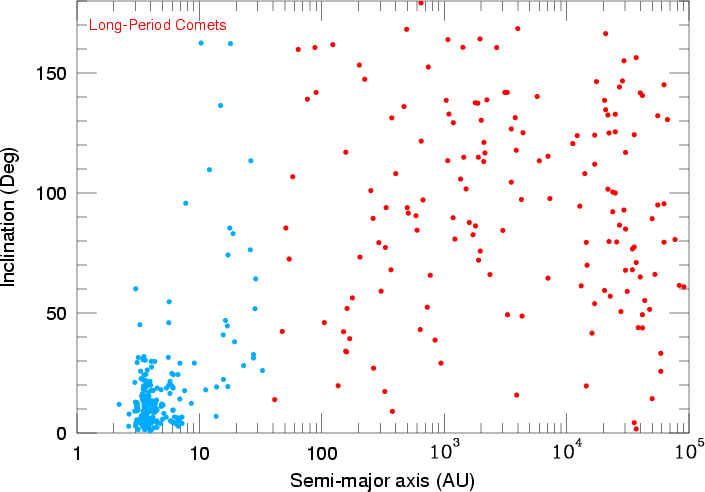
Figure CM603-F15. Inclination of orbits of comets to the Sun's equatorial plane. From [22].
The figure shows the inclinations of the orbits of comets, plotted against their semi-major axes in AU (for elliptical orbits, the semi-major axis is the distance from the centre to the maximum point, the equivalent of the radius of a circular orbit).
The blue dots represent short-period comets, ones which spend their entire lives within the 100 AU radius of the Heliosphere. These comets, such as Halley's Comet, are local and come back again after a period, about 75 years for Halley.
It can be seen that comets which stick close to the Sun have orbits only a few degrees away from the Equatorial Plane, while those which venture further afield have increasingly inclined orbits. The red dots represent comets which travel outside the Heliosphere, more than 100 AU out. The orbits of comets which travel this far out are essentially random with respect to the Equatorial Plane.
Notice that the inclinations don't go up just to 90 degrees, but to 180. Tilt an orbit up beyond 90 degrees, and you have an object travelling in the opposite sense round the Sun, say clockwise instead of anticlockwise. This is called a retrograde orbit -- Halley has such an orbit.
Equatorial Forcing
So, all the evidence is, that the planets have been forced into the Sun's equatorial plane of rotation from previously random inclinations, and that this effect, which can be called Equatorial Forcing (What is Equatorial Forcing?), is greater for bodies closer to the central body.
It appears that this gravitational effect, while pervasive, is quite slow in its action, taking maybe millions of years to show much effect. And this slow time-scale serves to give an answer to another long-unsolved cosmic puzzle, the origin of the Late Heavy Bombardment event (What was the Late Heavy Bombardment event?).
The LHB event was a time in the past history of the Solar System (about 4.1 to 3.8 billion years ago) when planets and moons had a great deal more impacts from space than now or earlier. The Solar System is about 4.7 billion years old, so the LHB started when the Solar System was about 600 million years old, and lasted for about 300 million years. Its origin has until now remained a mystery.
It is now apparent that this was the time when the planets and other space stuff, previously in random orbits, were being normalized so their orbits lay closer to the equatorial plane of the Sun.
This bringing of random-orbit planetary and asteroid-sized bodies in into a single plane would obviously make collisions more likely. So the orbit normalization caused by Equatorial Forcing is the obvious reason for the Late Heavy Bombardment.
In summary, Equatorial Forcing is a gravitational effect from a massive rotating body which causes smaller bodies within its gravitational influence to gradually move towards its own plane and direction of rotation. The effect on our Solar System planets has been shown, but the effect can also be seen elsewhere.
One of the most dramatic such effects can be seen in the Rings of Saturn, one of the most stunning objects to be seen in the heavens.
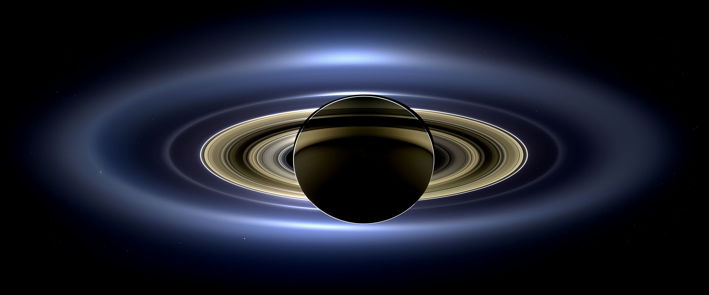
Figure CM603-F16. The full set of rings, imaged as Saturn eclipsed the Sun from the vantage of the Cassini orbiter, 1.2 million km distant, on 19 July 2013. From [25].
The Rings are the flattest known objects in the Solar System. With a width up to 80,000 km and a thickness of 10 metres, they are 8 million times wider than thick. Saturn's Rings orbit exactly above Saturn's equator, the inclination of the ring particle orbits to the equator is zero degrees [26].
While all the main rings orbit exactly above Saturn's equator, showing the complete influence of Equatorial Forcing, there is a deviant from the pattern. Well beyond the main rings is the Phoebe ring, which is tilted at an angle of 27 degrees to the other rings and, like the tiny moon Phoebe, orbits in retrograde fashion [25]. It is obviously a late-comer to the Saturn system, still in process of normalization.
In this way, Equatorial Forcing provides an answer to how Saturn's Rings were formed, another long-time puzzle. It also gives the reason why our Galaxy, the Milky Way, is in the form of a disc, rather than a sphere. The AGN or Supermassive Black Hole at the centre of the Galaxy is spinning extremely rapidly, and has influenced the stars and other objects within it to orbit in the AGN's own equatorial plane.
Here then is also the reason why some distant stars can be observed to have a disc of material orbiting about them. They are apparently stars old enough to have normalized most of the bodies which formed close to them within their bit of Oort Soup.
Planetary collisions and moon capture
It was pointed out earlier, that although Pluto can get closer to the Sun than Neptune, the two bodies can't crash into each other because their two orbits don't coincide anywhere. Pluto's tilted and elliptical orbit doesn't share space with Neptune's.
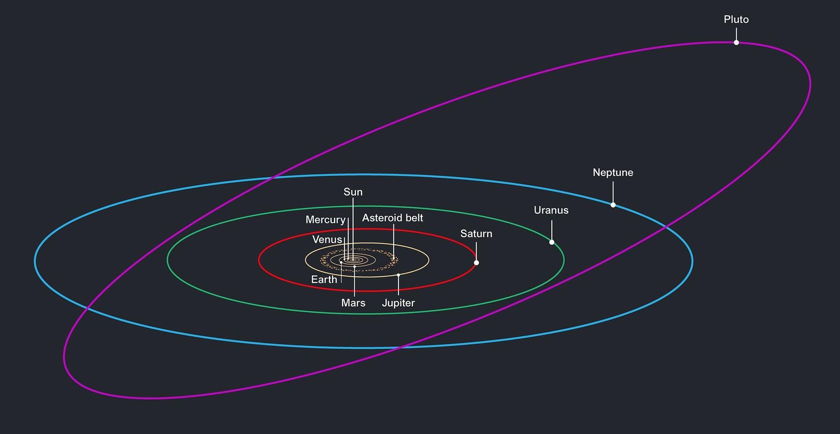
Figure CM603-F17. Orbits of Pluto and the planets. From [24].
However, if Equatorial Forcing eventually brought Pluto's orbit down closer to the Equatorial Plane of the planets, a collision would then be possible. But in such a case, rather than a collision, Neptune would probably take on Pluto and its companions as an extra six moons of its own.
In fact, it is very possible that most of the planets gained some or all or their moons by just this process. Reducing the orbit tilts of previously inclined smaller objects into the Equatorial Plane would allow their easy capture by a massive planet. This would explain how some of the outer planets have several moons in retrograde orbits, orbiting their primary in the opposite direction to their own revolution -- such moons were perhaps captured while travelling on a path going against the planet's rotation.
How to locate Planet Nine
The key to locating Planet Nine, and the many possible objects which may exist deeper into the Oort Cloud, is to pick them up from their infrared radiation.
We have seen that to spot them by the light they reflect from the Sun would be no easy task -- even the closest would be only one-thousandth as bright as Neptune. The long path out and back must sap the energy involved.
On the other hand, the infrared light which the larger, warmer bodies should be radiating has to travel only the distance from them to Earth. These Oort Cloud bodies should be detectable with telescopes tuned to particular infrared ranges. Luckily, there is not much competing radiation at these wavelengths, particularly in the mid-infrared.
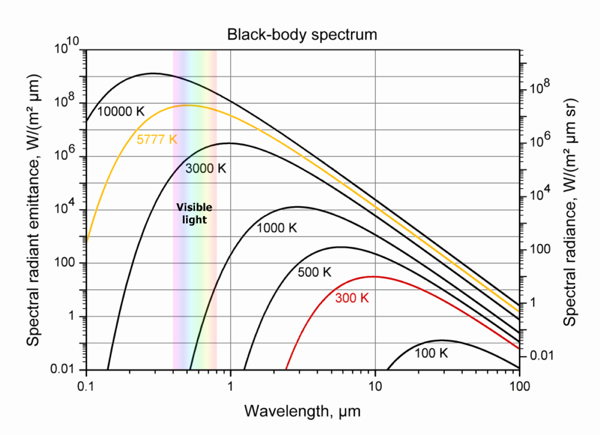
Figure CM603-F18. The black-body spectrum of objects cooler than stars. From [28].
We saw earlier that the peak radiation wavelengths for the outer planets ranged from 23 microns for Jupiter, up to 53 and 59 microns for Neptune and Uranus. If, as projected, Planet Nine has a mass about ten times that of the Earth, its infrared black-body peak should be around 70 microns.
In fact, the most fertile range to look for Oort Cloud objects from their black-body signatures should be in the 10-100 micron range, the mid-infrared. Below 10 microns, in the near-infrared or "heat" area, there should be quite a lot of competition from the light of cooler stars. Above 100 microns, on the way up to the CMBR at 1000 microns, a lot of far-infrared should be coming from smaller, cooler Oort bodies.
Dedicated mid-infrared telescopes should be able to pick up Oort planets and Oort substars in all directions of the Oort sphere. Their spectra should indicate their temperature, from their wavelength peak, and from this their mass could be estimated.
Out there in the vast spaces between the stars, there may be a whole new as yet unappreciated community of bodies. Almost certainly there are a host of binary planets, often with their own moons orbiting well beyond their mutual centre of gravity -- we have an example in our own Solar System, where Pluto and Charon form a double planet, with assorted moons orbiting around the doublet.
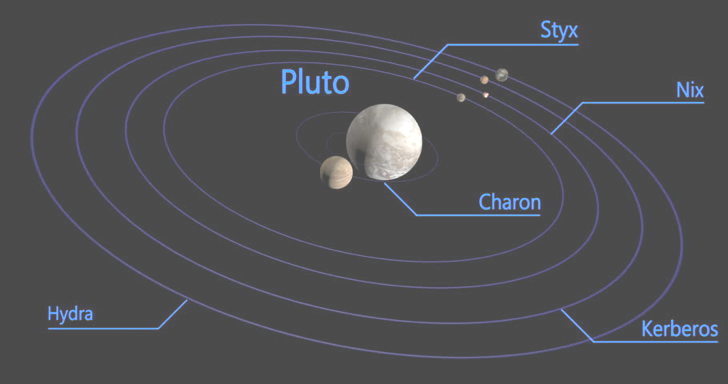
Figure CM603-F19. Pluto and its largest moon, Charon, orbit a common center of gravity. From [27].
Already mentioned is the possibility of "Subsolar Systems", systems of planets and other objects orbiting a massive central object, not quite large enough to become a star. These are sometimes called Brown Dwarfs. Wikipedia [29] says "Brown dwarfs are substellar objects that occupy the mass range between the heaviest gas giant planets and the lightest stars, of approximately 13 to 75 Jupiter masses".
Quite a lot is known about Brown Dwarfs, including that they may have attendant matter discs. Somewhat less massive objects, apparently isolated from any star, have been called Rogue Planets.
The first exoplanets, planets orbiting stars other than the Sun, were detected from changes in the level of light received from such stars when their planets passed across their faces. With expertise in mid-infrared spectral studies, it is apparent that suitably-oriented planets of subsolar stars could be detected from changes in the substars' infrared spectra.
Window to an unseen universe
If the model developed here is valid, if it reflects reality, it opens up a vista to a huge part of the Universe which has previously been obscured.
Almost all our knowledge of the Universe to date has been gathered using visible light to delineate stars and their closer companions -- solar systems. Yet these systems make up only about one-billionth of the volume of the Oort Soup matter which lies between the stars.
Finally, there is the intriguing possibility of life upon some of the Oort Soup objects. Life is known to exist in "hydrothermal vents", deep under Earth's oceans. This life gets by on locally-generated heat, quite independent of sunlight. There is no fundamental reason, then, why life could not flourish within the Oort Cloud.
* * * * * * * * * * * * * * * * * * * * * * * *

References and Links
[1]. Planet Nine. https://en.wikipedia.org/wiki/Planet_Nine .
[2]. Astronomy Homeschool Studies. https://www.pinterest.com.au/pin/253960866466773306/ .
[3]. Erik Gregersen. Heliosphere. https://www.britannica.com/topic/heliosphere .
[4]. Kuiper belt. https://en.wikipedia.org/wiki/Kuiper_belt.
[5]. List of Solar System objects by greatest aphelion. http://https://en.wikipedia.org/wiki/List_of_Solar_System_objects_by_greatest_aphelion .
[6]. The 3K Cosmic Background Radiation. http://hyperphysics.phy-astr.gsu.edu/hbase/bkg3k.html .
[7]. Radiated Power from Blackbody. http://hyperphysics.phy-astr.gsu.edu/hbase/quantum/radfrac.html .
[8]. Scottish Sceptic. Predicting the surface temperature on other planets. http://scottishsceptic.co.uk/2017/03/27/predicting-the-surface-temperature-on-other-planets/ .
[9]. Matt Williams. What is the average surface temperature of the planets in our solar system?. https://phys.org/news/2014-12-average-surface-temperature-planets-solar.html .
[10]. David Noel. Two Keys To Understanding The Earth: The Energy of Earthquakes, and the Cause of Expansion. http://www.aoi.com.au/TwoKeys/index.htm.
[11]. David Noel. P3: Living In The Universe: What CMBR tells us about Dark Matter, and much more. http://www.aoi.com.au/Living/ .
[12]. Black body emission max. http://www.calctool.org/CALC/phys/p_thermo/wien .
[13]. Planetary Fact Sheet - Ratio to Earth Values. https://nssdc.gsfc.nasa.gov/planetary/factsheet/planet_table_ratio.html .
[14]. Solar Radiation in Space. http://www.pveducation.org/pvcdrom/2-properties-sunlight/solar-radiation-space.
[15]. David Noel. Temperatures of the Earth: a globe in space. http://www.aoi.com.au/bcw/EarthTemp/ .
[16]. David Noel. Inside The Earth -- The Heartfire Model. http://www.aoi.com.au/bcw/Heartfire/ .
[17]. COBE Satellite. http://hyperphysics.phy-astr.gsu.edu/hbase/bkg3k.html .
[18]. David Noel. UG101: Recycling the Universe: Neutron Stars, Black Holes, and the Science of Stuff. http://www.aoi.com.au/Recycling/ .
[19]. David Noel. P2: The Oort Soup as the real origin of Cosmic Microwave Background Radiation. http://www.aoi.com.au/OortSoup/index.htm .
[20]. Early Chemistry of a Star's Protoplanetary Disc Shapes Life-Friendly Atmospheres. https://scitechdaily.com/early-chemistry-stars-protoplanetary-disc-shapes-life-friendly-atmospheres/.
[21]. Formation and evolution of the Solar System. https://en.wikipedia.org/wiki/Formation_and_evolution_of_the_Solar_System .
[22]. David Noel. P1: The Cosmic Smog model for solar system formation, and the nature of 'Dark Matter'. http://www.aoi.com.au/bcw1/Cosmic/index.htm .
[23]. David Noel. Deviating From The Mean: Standardization and Diversity [MT109]. http://www.aoi.com.au/MTSite/MT109.htm .
[24]. 10 Awesome Facts About Pluto!!!. https://steemit.com/trivia/@rohu03/10-awesome-facts-about-pluto-6b9cb9f83208e .
[25]. Rings of Saturn. https://en.wikipedia.org/wiki/Rings_of_Saturn .
[26]. David Noel. XT806: What is Equatorial Forcing? . http://www.aoi.com.au/Extracts/XT806.htm .
[27]. Seamless looping. https://www.shutterstock.com/video/clip-10225757-stock-footage-seamless-looping-the-planet-pluto-and-its-five-known-moons-orbit-realistically-pluto-and-its.html .
[28]. Black-body spectrum. http://www.sun.org/uploads/images/BlackbodySpectrum_2.png .
[29]. Brown dwarf. https://en.wikipedia.org/wiki/Brown_dwarf .
A condensed version of this article is at XT811 - Planet Nine, Doorkeeper to the Oort Worlds.
Go to the Cameos Home Page
Go to the AOI Master Page
Assembly started 2017 Dec 6. First version 1.0 on Web 2017 Jan 22.





















